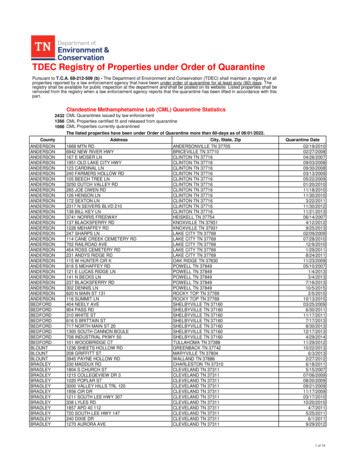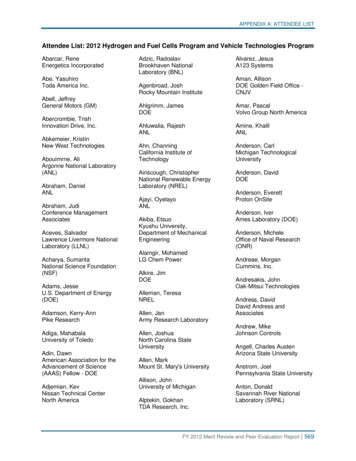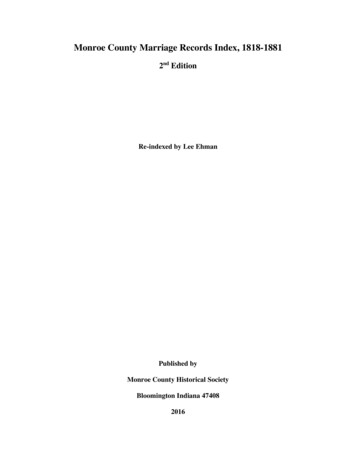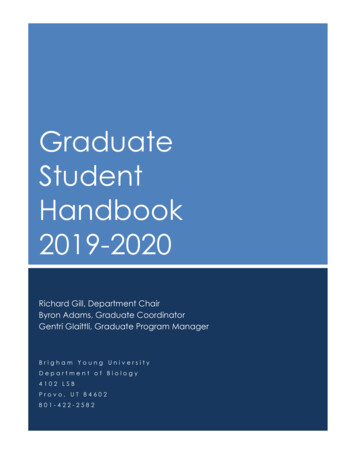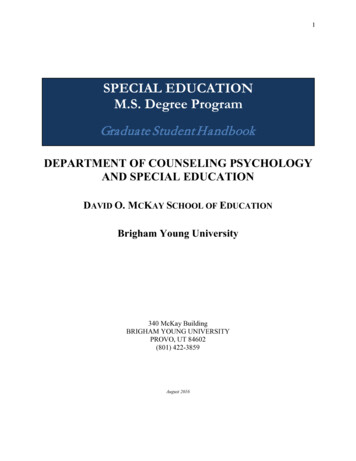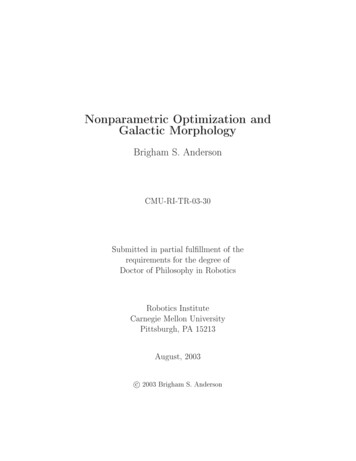
Transcription
Nonparametric Optimization andGalactic MorphologyBrigham S. AndersonCMU-RI-TR-03-30Submitted in partial ful llment of therequirements for the degree ofDoctor of Philosophy in RoboticsRobotics InstituteCarnegie Mellon UniversityPittsburgh, PA 15213August, 2003c2003 Brigham S. Anderson
AbstractThis thesis examines two areas of overlap between Memory-Based Reasoning(MBR) and stochastic optimization. The rst area is a solution to a galacticmorphology problem from astronomy: given a faint, distorted image of a galaxy,how can we determine its structure automatically and quickly?Solving thisproblem is of importance to the eld of astronomy, since there are now hundredsof millions of such images which have not been analyzed due to computationalcosts. The new algorithm, GMorph, follows the MBR paradigm by populatingimage space with several million "model" galaxies ahead of time. During runtime, we just nd the model image nearest to the unknown image. The moreinteresting issues are dealing with image distortion and speed.GMorph uses"eigengalaxies" to address both. Eigenspace has only a fraction of the numberof dimensions that image space does, so deconvolution is faster, more stable, andmore accurate. We achieve signi cant improvements in speed over previouslypublished techniques.We also introduce a new algorithm for optimization of similarity-based data.In a problem where only the similarity metric is de ned, a gradient is rarelypossible. The essence of MBR is the similarity metric among stored examples.The new algorithm, Pairwise Bisection, uses all pairs of stored examples todivide the space into many smaller spaces and uses a nonparametric statistic todecide on their promise. The nonparametric statistic is Kendall's tau, which isused to measure the probability that a given point is at an optimum. Because itis fundamentally nonparametric, the algorithm is also robust to non-Gaussiannoise and outliers.
To my mother and father, to whom I owe just about everything
AcknowledgementsI would like to thank my advisor, Andrew Moore, who provided such an inspirational model throughout my graduate studies.Andrew was perpetuallysupportive and enthusiastic, and could be counted on to have a clever idea upeach sleeve at any given time.I am indebted also to my wife, K.C., for her heroic patience and love throughout the writing process. I also thank my adorable daughter, Aurora, who reminded me often and loudly what (or who) is really important in life.Many thanks also to my thesis committee, Andrew Moore, Chris Atkeson(CMU RI), Leslie Kaelbling (MIT), Andrew Connolly (University of Pittsburgh,Astrophysics), and Matt Mason (CMU RI) for their ingenious questions andadvice during the research process.Their suggestions for the thesis were allexcellent and improved the document tremendously. I also thank Robert Nichol(CMU Astrophysics) for his ethusiastic discussions and support. David Cohen,currently at Google, was a creative early supporter of the work on pairwiseoptimization.Many enjoyable brainstorming sessions with Dave and Andrewwere spent improving the algorithm.Finally, I have to say that nothing whatsoever might have been done if not forthe assistance of Suzanne Lyons-Muth in all matters administrative. Suzannemade the hoops of graduate school a pleasure.
Contents1 Introduction11.1Motivation: Memory Based Reasoning in Optimization . . . . . .11.2Overview of Thesis . . . . . . . . . . . . . . . . . . . . . . . . . .32 Optimization Background42.1Optimizing Noisy Functions Without Gradients . . . . . . . . . .52.2Systematic Search72.3. . . . . . . . . . . . . . . . . . . . . . . . . .2.2.1Coordinate Directions. . . . . . . . . . . . . . . . . . . .72.2.2Conjugate Directions/Powell's Method . . . . . . . . . . .82.2.3Finite-Di erence Approximations (FDA) . . . . . . . . . .92.2.4Quasi-Newton Descent with FDA . . . . . . . . . . . . . .92.2.5Nelder-Mead Simplex Search92.2.6Experiment design and Response surface methods2.2.7PMAX and IEMAX. . . . . . . . . . . . . . . . . . .10. . . . . . . . . . . . . . . . . . . . .13Random Search . . . . . . . . . . . . . . . . . . . . . . . . . . . .142.3.1Stochastic Approximation . . . . . . . . . . . . . . . . . .142.3.2Simulated Annealing . . . . . . . . . . . . . . . . . . . . .152.3.3Evolutionary computation. . . . . . . . . . . . . . . . .172.3.4Q2 . . . . . . . . . . . . . . . . . . . . . . . . . . . . . . .172.4Least-Squares Model-Fitting. . . . . . . . . . . . . . . . . . . .182.5Summary. . . . . . . . . . . . . . . . . . . . . . . . . . . . . . .19v
viCONTENTS3 Galaxy Morphology Background203.1Problem . . . . . . . . . . . . . . . . . . . . . . . . . . . . . . . .203.2Notation . . . . . . . . . . . . . . . . . . . . . . . . . . . . . . . .233.3Modeling Galaxy Images . . . . . . . . . . . . . . . . . . . . . . .233.3.1. . . . . . . . . . . . . .303.4The Nonlinear Regression Problem . . . . . . . . . . . . . . . . .313.5Another Approach: GIM2D . . . . . . . . . . . . . . . . . . . . .343.6Summary35Parameters Comprising space. . . . . . . . . . . . . . . . . . . . . . . . . . . . . . .4 GMorph374.1Model Decomposition. . . . . . . . . . . . . . . . . . . . . . . .384.2Eigengalaxies . . . . . . . . . . . . . . . . . . . . . . . . . . . . .414.3Local Eigenspaces45. . . . . . . . . . . . . . . . . . . . . . . . . . . . . . . . . . . . . . . . .45. . . . . . . . . . . . . . .47. . . . . . . . . . . . . . . . .48Masking Eigengalaxies . . . . . . . . . . . . . . . . . . . .494.4Finding the Nearest Neighbor . . . . . . . . . . . . . . . . . . . .504.5Algorithm Summary . . . . . . . . . . . . . . . . . . . . . . . . .524.6Experiments . . . . . . . . . . . . . . . . . . . . . . . . . . . . . .584.6.1Data Fits584.6.2Simulation Experiments Overview. . . . . . . . . . . . .644.6.3Timing Experiments . . . . . . . . . . . . . . . . . . . . .664.6.4Catalog Parameter Experiments. . . . . . . . . . . . . .694.6.5Noise and PSF Experiments . . . . . . . . . . . . . . . . .734.74.3.1PSF-Localized Eigengalaxies4.3.2O set-Localized Eigengalaxies4.3.3Picking a Local Eigenspace4.3.4Summary. . . . . . . . . . . . . . . . . . . . . . . . . . . . . . . . . . . . . . . . . . . . . . . . . . . . . . . . .5 Pairwise Bisection Optimization5.17879Background . . . . . . . . . . . . . . . . . . . . . . . . . . . . . .805.1.1PABI825.1.2Experiments. . . . . . . . . . . . . . . . . . . . . . . . . . . . . . . . . . . . . . . . . . . . . . . . . . . . .84
viiCONTENTS5.1.3Summary. . . . . . . . . . . . . . . . . . . . . . . . . . .6 Conclusions and Future Work6.1Future Research. . . . . . . . . . . . . . . . . . . . . . . . . . .888989
List of Figures2.1Coordinate Directions search. The search proceeds by performing sequential one-dimensional searches (represented by line segments) along alternating coordinates.2.2. . . . . . . . . . . . . . .7Simplex algorithm. At each step, the algorithm changes the polyhedron's shape to adapt to the terrain and move toward the optimum. The di erent movement options depend on the environment, e.g., the default step is re ection, but if the trial step isbetter than the best so far, then re ect and expand. . . . . . .102.3Three-level Factorial design for a 2- and 3-dimensional input space. 112.4Central Composite design for a 2- and 3-dimensional input space.2.5PMAX and IEMAX algorithms in action. The middle line is the12best- tting model surface, while the upper and lower lines are95% and 5% con dence interval boundaries, respectively. PMAXwould choose B for the next experiment, a risk-seeking IEMAX algorithm would choose A, and a risk-averse IEMAX would chooseC.2.6. . . . . . . . . . . . . . . . . . . . . . . . . . . . . . . . . . .12PMAX in some di culty. The dashed line is the true function,and the solid line is PMAX's current model of the function. Someunlucky early points have created a spurious optimum, whichPMAX will not escape from. . . . . . . . . . . . . . . . . . . .viii14
ixLIST OF FIGURES3.1Image from Sloan Digital Sky Survey (SDSS). Most of the elliptical objects are galaxies.3.2. . . . . . . . . . . . . . . . . . . . . .21Hubble tuning fork diagram. The fundamental division of galaxies is into ellipticals (E) and spirals (S). The number after theellipticals is the ratio of their major axis to their minor axis,called the ellipticity.The size of the central bulge diminishesfrom left to right. . . . . . . . . . . . . . . . . . . . . . . . . . . .3.3Galaxy images taken from the Groth Survey Strip, lterField 8, wide eld camera chip 3.Image scaletotal exposure time 4400 seconds [52].3.4Contours of bulge and disk images.21I814 ,0":1 pixel and. . . . . . . . . . . . . . .22The contour lines are atpowers of 10 and are at equivalent intervals between images. The70Æ with an 18 pixel radius, and the bulge has 0ellipticity with a 25 pixel radius. The images are 64 64. . . . .disk is tilted3.524Disk and bulge pro le examples. Moving from left to right insidethe gure, the pro les have 1,4,16, and 64 pixel radii. The totalux has been manipulated for all 8 pro les so as to have thebrightness at the center equal one.pro les would be invisibly at.3.6Otherwise, the larger radii. . . . . . . . . . . . . . . . . . .26Disk and bulge. The ellipses mark all points of equal distance,r; from the center.The disk component, left, is interpreted as a2-dimensional disk in 3-dimensional space, while the bulge is a2-dimensional ellipsoid. . . . . . . . . . . . . . . . . . . . . . . . .3.727Two synthetic galaxies (A and B) before and after convolutionwith a Gaussian PSF with a standard deviation of 2 pixels. Theimages are64 64 pixels. . . . . . . . . . . . . . . . . . . . . .28
xLIST OF FIGURES3.8. Relationships withinf ; ; S; Y g.Galaxies are generated by and mapping it viataking a point from parameter spaceinto image space, where it is then convolved withanother point in image space. Input imageYS , resulting inis assumed to havebeen generated by this process and then had a Gaussian noisevector3.9e added to it. . . . . . . . . . . . . . . . . . . . . . . . .31The many-to-one di culty with deconvolution. Suppose the mapping is one of convolving images with a PSF. Many di erentimages can produce an identical blurred image (bottom point).However, if we know that the original image came from a restricted subset ofRN(upper curved line segment), then we canperhaps reduce the possibilities to a narrow range.4.1. . . . . . . .33Factored sampling of the model space. The open circles are puredisks and the lled circles are pure bulges. All linear combinationsof two endpoint images are depicted as a line segment. (In realitythey are planes. See Figure 4.2.) From the six images sampled,an in nite number of sample images can be produced, which alsocover a much larger area of the image space. . . . . . . . . . . . .4.2Bulge/disk decomposition. Vectorbis the bulge image,d is39thedisk image. The shaded wedge-shaped plane that is bounded bythe two vectors is the space of all images that this particulardisk/bulge combination can represent.pointy , and its best t to (d; b) is its projection onto the shadedplane, obtained by Equation 4.2.4.3The input image is the. . . . . . . . . . . . . . . . . .perpendicular with a length ofeigencoordinates would be1: In this case, the rst and secondT y1andT2 y, where the dashed linesintersect the coordinate system. The vector is the reconstruc-tion error. . . . . . . . . . . . . . . . . . . . . . . . . . . . . . . .4.440NEigenspace projection is a linear subspace of R : The bases i are41The rst 15 eigengalaxies obtained by the procedure in section 4.2. 42
xiLIST OF FIGURES4.5Adding an eigenspace. The new spacesubspace ofRn . . . . . . . . . . . . . . .plained by the .Percent variance ex-i-th eigenvector in is obtained by P .jiNj. . . .44The rst 15 eigengalaxies obtained from galaxies convolved witha Gaussian PSF with 2-pixel standard deviation.4.843Percent of synthetic galaxies' variance that is explained by increasing the number of eigenvectors in4.7dimensionalThe same linear relationships apply in thiseigenspace as did in the image space.4.6( ) is a KspanE ect of PSF mismatch. . . . . . . . .46The catalog's one PSF is a Gaussianwith 2-pixel standard deviation. For each point on the plot, 100simulated galaxy images were generated by the process describedin Section 4.6.2 using a PSF which is a Gaussian of varying stan-x axis).dard deviation (The variance explained achieved with thecatalog is plotted on theerror bars are the4.9yaxis. Circles are the median values,25th and 75th percentiles. . . . . . . . . . . .47The nal PSF correction. Assuming that the undistorted imagex lies in eigenspace (on left), then yin space S will have thesame coordinates. . . . . . . . . . . . . . . . . . . . . . . . . . . .4.10 Finding the nearest neighbor. In the eigenspacetransformed input image ( ), from the48spanT y , nd the closest linear combinationof a known disk and known bulge.4.11 Coordinate search example. . . . . . . . . . . . . . . . .50The bulges and disks are roughlyordered by radius size, but otherwise have no intrinsic ordering.The search begins at the#3300. ,with disk #1550 and bulgeThe search proceeds in the bulge direction and ndsa minimum with bulge #2050. The best disk is then found tobe #1700, and so on. The following is the full search trajectory:(1550,3300),(1550,2050),(1700,2050), (1700,2450) ,(1900,2450),(1900,2600).The nal point is a local minimum for this search. . . . . . . .51
xiiLIST OF FIGURES4.12 Coordinate search example. Multiple start points often enter thesame trajectory.Multiple local minima ( lled circles) also arefrequent. The scale of the plot is twice that of Figure 4.11. . .524.13 Image #101 and resulting t. The plots, left to right, are: theoriginal image, model image, residual image, search trajectory(ies),data and tted pro les, and search space with best 10% and 1%of models shown. . . . . . . . . . . . . . . . . . . . . . . . . . . .604.14 Image #102 and resulting t. The plots, left to right, are: theoriginal image, model image, residual image, search trajectory(ies),data and tted pro les, and search space with best 10% and 1%of models shown. . . . . . . . . . . . . . . . . . . . . . . . . . . .604.15 Image #120 and resulting t. The plots, left to right, are: theoriginal image, model image, residual image, search trajectory(ies),data and tted pro les, and search space with best 10% and 1%of models shown. . . . . . . . . . . . . . . . . . . . . . . . . . . .614.16 Image #126 and resulting t. The plots, left to right, are: theoriginal image, model image, residual image, search trajectory(ies),data and tted pro les, and search space with best 10% and 1%of models shown. . . . . . . . . . . . . . . . . . . . . . . . . . . .614.17 Image #292 and resulting t. The plots, left to right, are: theoriginal image, model image, residual image, search trajectory(ies),data and tted pro les, and search space with best 10% and 1%of models shown. . . . . . . . . . . . . . . . . . . . . . . . . . . .624.18 Image #354 and resulting t. The plots, left to right, are: theoriginal image, model image, residual image, search trajectory(ies),data and tted pro les, and search space with best 10% and 1%of models shown. . . . . . . . . . . . . . . . . . . . . . . . . . . .624.19 Image #43 and resulting t. The plots, left to right, are: the original image, model image, residual image, search trajectory(ies),data and tted pro les, and search space with best 10% and 1%of models shown. . . . . . . . . . . . . . . . . . . . . . . . . . . .63
xiiiLIST OF FIGURES4.20 Execution times. Distribution of tting times in seconds for 416SDSS samples using the procedure described in Section 4.6.1. . .4.21 Sample of synthetic galaxies.64No PSF. Contour lines occur atpowers of 10. Signal-to-noise ratio is 100. Background noise isequal to signal noise. . . . . . . . . . . . . . . . . . . . . . . .4.22 Execution times vs. catalog resolution. . . . . . . . . . . . . .4.23 Mean execution times vs. number of catalog subpixel o sets.67. .67. . . . . . . .67. . . . . . . . . . . . . . .684.24 Mean execution times vs. number of eigenimages.4.25 Execution times vs. raw catalog size.644.26 The e ect of the number of eigenimages, the number of catalogimages, and the number of subpixel o sets on ux accuracy. Eachdata point is the mean result for 1000 simulated galaxies. Verticalbars cover one standard deviation in each direction. . . . . . .704.27 The e ect of various algorithm parameters on ux accuracy. Plotsare of the mean absolute log( tted/true) of the ux values. Thevertical bars cover a 95% con dence interval for the estimatedmean. Each data point summarizes the results for 1000 simulatedgalaxies. . . . . . . . . . . . . . . . . . . . . . . . . . . . . . .714.28 Fitting errors with respect to S/N. Error is the log( tted/true)of the parameter values. Each point is the mean of a minimumof 150 di erent error measurements, and the vertical bars coverone standard deviation in each direction. . . . . . . . . . . . .724.29 Magnitude of tting errors with respect to S/N. Plots are of theaverage absolute log( tted/true) of the parameter values.Thevertical bars cover a 95% con dence interval for the estimatedmean. Note that B/T error is the average absolute di erence. . .73
xivLIST OF FIGURES5.1Example calculation of the statisticwith two input dimensions.Each circle is a point in two-dimensional space, with theinside the circle.y valueSolid lines are the perpendicular bisectors ofeach pair of points.For each pair's bisector, a solid triangleindicates the direction of the smaller of the two points.or -1 indicates whether the query pointXA 1is on the same side ofthe bisector as the smaller of the two points. The statisticXisequivalent to the sum of these numbers divided by the number ofbisectors.5.2. . . . . . . . . . . . . . . . . . . . . . . . . . . . . . .The test functions used to evaluate performance. The task wasto maximize the value of the test function.8581
List of Tables4.1Systematic and random errors in total ux. Upper table: MeanF)di erence between log(F)and recovered log(signal-to-noise and PSF size.as a functionLower table: Standard deviationF ) and recovered log(F ). . . . . . . . .Systematic and random errors in B T ratio. Upper table: Meandi erence between B T and recovered B T as a function signalin di erence between log(4.275to-noise and PSF size. Lower table: Standard deviation in di erence between4.3B Tand recoveredB T . . . . . . . . . . . . . .75Systematic and random errors in disk radius . Upper table: Meandi erence between log(rd)rd )and recovered log(as a functionsignal-to-noise and PSF size. Lower table: Standard deviation inrd ) and recovered log(rd).di erence between log(4.4Systematic and random errors in bulge radius.Mean di erence between log(. . . . . . . . .76Upper table:re ) and recovered log(re ) as a func-tion signal-to-noise and PSF size. Lower table: Standard devia-re ) and recovered log(re ).tion in di erence between log(4.5. . . . .76Correlations in high-signal conditions. Correlations between selected parameters and types of errors when the total signal-tonoise is greater than 1000.with no PSF.Sample of 3000 simulated galaxies. . . . . . . . . . . . . . . . . . . . . . . . . . . . .xv77
xviLIST OF TABLES4.6Correlations in low-signal, high-noise conditions. Correlations between selected parameters and types of errors when 10 S/N 100.Sample of 3000 simulated galaxies with no PSF.5.1. . . . . . . . .77The functions used are those from Figure 5.2, with the goal ofmaximization.Numbers in columns are mean score of last 15experiments out of 60. The sample size is 25. Noise' is normallydistributed with a standard deviation of 0.3. Outliers' indicatesthat with probability 0.1, noise will be an order of magnitudegreater (standard deviation 3.0). 2dims' indicates that two irrelevant input dimensions were added to the function. Signi cantp 0:05) results are denoted by an asterisk, and indicate that(the algorithm tested signi cantly better than all other methodson that task. Due to the highly non-normal distribution of thesemeans (bimodal in many cases) a nonparametric rank-sum testwas used to determine signi cance. . . . . . . . . . . . . . . . . .87
Chapter 1Introduction1.1Motivation: Memory Based Reasoning in Optimization1Memory-Based Learningis a form of supervised inductive learning from ex-amples. The algorithm is given labelled examples of di erent patterns that thelearner might encounter during operation. After the learning phase, if a newpattern is presented to the algorithm, it will attempt to generalize from examples in its memory that are similar to the unknown pattern. The approach isbased on a model of thought where reasoning occurs by direct reuse of storedexperiences rather than the application of knowledge (such as rules or decisiontrees) abstracted from experience.In memory-based learning, induction is based on the use of similarity [1,53].Similarity is a measure of how close' one pattern is to another.Themain generalization technique employed by memory-based learning systems isthe nearest-neighbor search.When using nearest-neighbor search to classifyincoming patterns, a new query's similarity to all other instances in memoryis determined, and the classi cation of the closest or most similar pattern in1 Also referred to as Lazy, Model-free, Nonparametric, Case-Based, Exemplar-Based,Similarity-Based, or Instance-Based learning.1
CHAPTER 1.2INTRODUCTIONmemory is returned. There are numerous techniques for streamlining this basicstrategy [7, 16, 34].Memory-Based Reasoning has a long history in arti cial intelligence amongseveral disciplines (e.g., computer vision and language processing) [53]. Memorybased reasoning can be viewed as a type of function approximator, and has beenused in many domains, e.,g., control [4, 33], locally weighted learning [3], naturallanguage processing [10, 49], face recognition [51], and optimization [36].The advantages of memory-based methods over other knowledge models include transparency , the learning process is easy to visualize and understand, andtherefore is easy to work with. exibility in representation , given enough examples, a memory-based learnercan learn an arbitrary function [12]. fast learning ,learning an example is accomplished merely by storing theexample in memory. No further processing is required. incremental learning, new examples can be learned at any time during thelifetime of the learner, and locality,the learner only uses data which is most similar/relevant to thequery.In this thesis we introduce two algorithms that perform nonparametric optimization. The rst is a system that uses memory-based methods to determinethe best- tting morphology of two-dimensional images of galaxies. The secondis an optimization technique that uses a nonparametric model of data duringoptimization.Understanding galaxy morphology is a necessary step in understanding theformation of large scale structures in the universe.This is still an open areaof research in astronomy; we currently do not know how certain galaxy shapesarise. A great deal of progress can be achieved by extracting data from large
CHAPTER 1.3INTRODUCTIONnumbers of faint and noisy images, e.,g., whether the galaxy is spherical, elliptical, or disk-shaped, the size of the central bulge vs.the size of the disk,etc. The distribution of these structural parameters will aid in the testing ofcosmological theories [52].We introduce an algorithm addressing this galaxy morphology task.Thealgorithm must be able to t a galaxy image model to a (possibly blurred) dataimage, and it must be able to do so quickly. After much trial and error, themost successful algorithm type was found to be Memory-Based Reasoning. Inthis case, memory-based means that an initial random population of syntheticimages of galaxies are generated and then stored. When a query image comesin, it is compared to this population, and the nearest image's parameters arereturned.1.2Overview of ThesisThe structure of the thesis will be the following:Chapter 1 contains a brief overview of memory based reasoning and optimization.Chapter 2 is a background of the major classes of nonlinear optimizationtechniques.Chapter 3 describes the galaxy morphology problemChapter 4 proposes a new algorithm for solving it much faster than currenttechniques do. The algorithm uses MBR techniques in new domain.Chapter 5 describes a new algorithm for optimizing in a memory-like space.Chapter 6 discusses the conclusions of this work and directions for futureresearch
Chapter 2Optimization BackgroundMany disciplines have methods relevant to stochastic global optimization. Resistance to noise and experimental e ciency varies widely among these methods.Numerical methods have produced a large number of algorithms for locatingoptima. Generally, these algorithms have been designed to work on known functions with no noise. Their e ectiveness within these domains and mathematicalguarantees makes them popular examples of optimization algorithms.Extremely e cient numerical algorithms exist to optimize one-dimensionalfunctions without the use of gradients (e.g., Golden ratio, Brent's Method [45].)However, multidimensional problems have proven much more di cult. Numerical optimization of multidimensional functions mostly consist of line minimizations in combination with clever methods for determining search directions. Twowell-known optimization algorithms that do not require gradients are conjugatedirections and quasi-newton/variable-metric methods.4
CHAPTER 2.2.15OPTIMIZATION BACKGROUNDOptimizing Noisy Functions Without GradientsOptimization of a process involves nding the highest peak (or deepest basin)on the underlying function surface. However, without prior knowledge of theshape of the function, this task requires an in nite number of experiments [56].Therefore, we restrict our task to one of nding a goodlocaloptimum.Wealso restrict the task to minimization, since any maximization problem can beconverted to one of minimization by changing the sign of the function.One can express the problem of optimizing a functionan inputofxtofthat produces the smallest outputglobal minimum 1 x globforff : Rnf (x).! R as ndingThe strict de nitionisf (x glob ) f (x) 8x 2 V (x); x 6 x globV (x) is the set of feasible values of the variable x.local minimum of f ifwhereA pointx loc is a strongf (x loc ) f (x) 8x 2 N (x loc ; ); x 6 x locN (x loc ; ) is de ned as the set of feasible points contained in the neigh borhood of xloc , i.e., all points within some arbitrarily small distance of xloc . Alternatively, if the function f is smooth, for the vector x to be a localwhereminimum offthe following is both necessary and su cient:a: krf (x )k 0b: rrf (x ) is positive de nite(2.1)However, often during optimization of some processes, one cannot measuref , rf , or rrf , but only the output y. The observed output y is the sum off (x) and some random variable ". This source of noise, ", we assume to be1 Excludesthe possibility of multiple global optima.
CHAPTER 2.6OPTIMIZATION BACKGROUND2independent, identically distributed , and have a mean of zero.y(x) f (x) "Noise contamination,";confounds the optimization problem.(2.2)Noise canmask the presence of true optima and create illusions of optima where none exist.Noise can be created by measurement errors, variations in the environment, andinherent randomness in the process. The type of noise is another factor, methodswill have di ering success with Gaussian noise, non-Gaussian noise, and outliers.The actual underlying function,f; of empirical processes is usually unknown.Non-di erentiability results from this, since the experimenter cannot analytically determine gradients.The lack of gradient is a signi cant factor in thechoice of algorithm, since most algorithms use rst or second derivatives, e.g.,Steepest descent, Newton's method, Conjugate gradients, and Variable metricmethods.When optimizing an empirical process, the cost of experiments is more oftena dominating factor than computational cost. Researchers and engineers in thereal world have limited time and funding for exhaustive experimentation. Experiments with a chemical plant may cost thousands of dollars per experiment.A robot janitor may get the opportunity to test a parameter setting once a day.Because of cost, the number of function evaluations required can make or breakalgorithms optimizing empirical processes. In empirical processes, it is often thecase that the cost of the experiments (or function evaluations) exceeds the costof computation.An example characterizing this type of problem is a biochemist who must setthe temperature and enzyme concentration of a reaction in order to maximizeyield. The underlying functionf (x) is the expected yield of the reaction.He hasno idea what the underlying function or its gradients look like. The researchercan adjust the parameter vector2 Allx(temperature and enzyme concentration.)the errors are independently generated from the same probability distribution.
CHAPTER 2.7OPTIMIZATION BACKGROUNDfigs/fig coord dir eg.eps not found!Coordinate Directions search. The search proceeds by performing sequential one-dimensional searches (represented by line segments) along alternating coordinates.Figure 2.1:The outputy(x) represents the observed yield, and is corrupted by noise suchas reagent variation, measurement error, and technician error. The task of theoptimizer is to ndx ,which is the combination of temperature and enzymeconcentration with the greatest expected yield.The cost of each dosage ofenzyme is much more than the cost of the computer time per experiment.2.2Systematic Search2.2.1 Coordinate DirectionsCoordinate descent forms the basis for directional desce
Masking Eigengalaxies. 49 4.4 Finding the Nearest Neigh bor. 50 4.5 Algorithm Summary. 52 4.6 Exp erimen ts . 58 4.6.1 Data Fits. 58 4.6.2 Sim ulation Exp erimen ts Ov erview. 64 4.6.3 Timing Exp erimen ts. 66 4.6.4 Catalog P arameter Exp erimen ts. 69 4.6.5 . optim um, whic h PMAX will not escap e from. 14 viii. LIST OF FIGURES ix 3.1


